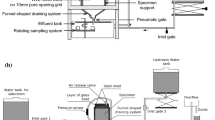Abstract
This chapter is devoted to the advanced stages of erosion characterized by a mass loss curve of a sample exposed to cavitation as a function of exposure time. Depending upon materials, erosion devices, and operating conditions, different regimes of erosion may be identified on the mass loss curve including incubation, acceleration, deceleration, and steady-state periods. Typical mass (or volume) loss curves obtained for different materials using ultrasonic cavitation, cavitating jets, and a high-speed cavitation tunnel are discussed. They can be normalized by introducing a characteristic volume loss and a characteristic time, which are unique functions of the material and the cavitating field condition. By computing the ratio of characteristic volume loss and characteristic time, the characteristic erosion rate can be deduced for allowing material ranking. The ranking deduced from vibratory cavitation tests and from cavitating jet tests is generally in agreement. Some materials, however, do not rank the same way in a cavitating flow of relatively low aggressiveness (such as vibratory cavitation) as compared to the cavitating flow of higher aggressiveness (high speed cavitating jets).
Access this chapter
Tax calculation will be finalised at checkout
Purchases are for personal use only
Similar content being viewed by others
References
Knapp RT, Daily JW, Hammitt FG (1970) Cavitation. McGraw Hill Book Co., New York
Hammitt FG (1980) Cavitation and multiphase flow phenomena. McGraw-Hill International Book Co., New York
Thiruvengadam A (1974) Handbook of cavitation erosion. Hydronautics, Laurel
Eisenberg P, Preiser HS, Thiruvengadam A (1965) On the mechanisms of cavitation damage and methods of protection. Trans Soc Naval Architects Mar Eng 73:241–286
Arndt R, Billet M, Blake W (eds) (1993) ASME symposium on bubble noise and cavitation erosion in fluid systems, FED-Vol. 176. New Orleans
Rohatgi U, Nagafuji T (eds) (1991) Cavitation erosion power symposium, 1st ASME-JSME fluid engineering conference, Portland, 23–27 June 1991
Peterson R (ed) (1962) Symposium on Erosion and Cavitation, ASTM International STP 307. Philadelphia, Pennsylvania (also (1961) 64th annual meeting, ASTM. Atlantic City)
Peterson R (ed) (1961) Symposium on Erosion and Cavitation, 64th annual meeting, ASTM. Atlantic City
Annual Book of ASTM Standards (2010) Section 3: metals test methods and analytical procedures, vol. 03.02. West Conshohocken
Pereira F, Avellan F, Dupont P (1998) Prediction of cavitation erosion: an energy approach. J Fluids Eng 120(4):719–727
March PA (1987) Evaluating the relative resistance of materials to cavitation erosion: a comparison of cavitating jet results and vibratory results. Paper presented at the ASME cavitation and multiphase flow forum, Cincinnati, 14–17 June 1987
Hattori S, Takinami M, Otani T (2009) Comparison of cavitation erosion rate with liquid impingement erosion rate. Paper presented at the 7th international symposium on cavitation, Ann Arbor, 17–22 Aug 2009
Hammitt FG, Chao C, Kling CL, Mitchell TM, Rogers DO (1970) Round-Robin Test with Vibratory Cavitation and Liquid Impact Facilities of 6061–T6511 Aluminum Alloy, 316 Stainless Steel and Commercially Pure Nickel. Materials Research and Standards (ASTM) 10:16–36
Chao C, Hammitt FG, Kling CL (1968) ASTM round-robin test with vibratory cavitation and liquid impact facilities of 6061-T6 aluminum alloy, 316 stainless steel, commercially pure nickel, vol 84. The University of Michigan Report MMPP-344-3-T/01357-4-T, Ann Arbor
Choi J-K, Jayaprakash A, Chahine GL (2012) Scaling of cavitation erosion progression with cavitation intensity and cavitation source. Wear 278–279:53–61. doi:10.1016/j.wear.2012.01.008
Odhiambo D, Soyama H (2003) Cavitation shotless peening for improvement of fatigue strength of carbonized steel. Int J Fatigue 25(9–11):1217–1222. doi:10.1016/s0142-1123(03)00121-x
Soyama H, Futakawa M (2004) Estimation of incubation time of cavitation erosion for various cavitating conditions. Tribol Lett 17(1):27–30
Chahine GL, Courbière P (1987) Noise and erosion of self-resonating cavitating jets. J Fluids Eng 109(4):429–435
Martin F, Lemieux E, Newbauer T, Bayles R, Natishan P, Khan H, Michal G, Ernst F, Heuer A (2007) Localized corrosion resistance of LTCSS-carburized materials to seawater immersion. ECS Trans 3(31):613–621
Zhou YK, Hammitt FG (1983) Cavitation erosion incubation period. Wear 86(2):299–313
Hammitt FG (1979) Cavitation erosion: the state of the art and predicting capability. Appl Mech Rev 32(6):665–675
Author information
Authors and Affiliations
Corresponding authors
Editor information
Editors and Affiliations
Rights and permissions
Copyright information
© 2014 Springer Science+Business Media Dordrecht
About this chapter
Cite this chapter
Chahine, G.L., Franc, JP., Karimi, A. (2014). Mass Loss and Advanced Periods of Erosion. In: Kim, KH., Chahine, G., Franc, JP., Karimi, A. (eds) Advanced Experimental and Numerical Techniques for Cavitation Erosion Prediction. Fluid Mechanics and Its Applications, vol 106. Springer, Dordrecht. https://doi.org/10.1007/978-94-017-8539-6_5
Download citation
DOI: https://doi.org/10.1007/978-94-017-8539-6_5
Published:
Publisher Name: Springer, Dordrecht
Print ISBN: 978-94-017-8538-9
Online ISBN: 978-94-017-8539-6
eBook Packages: Physics and AstronomyPhysics and Astronomy (R0)




